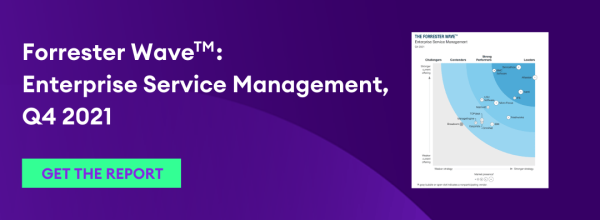Despite the Covid-19 pandemic, mergers and acquisitions are up. In the year leading up to June 30th, 2021, there were 16,672 M&As in the US—up from 13,446 in the previous year. That’s a 24% increase.
Mergers and acquisitions are complex and disruptive. The post-merger integration of organizational structures, cultures, processes, assets, accounts, and technology can take months. Every aspect of business needs to transition to a new state.
M&As are opportunities
It is both a challenge and an opportunity. The challenge is to make it work and realize the new value intended. The opportunity is to create a new organization that is greater than the sum of its parts while doing it.
This is where Enterprise Service Management (ESM) can help—with both the transitional aspects of Post Merger Integration (PMI) and the reimagining of how the new, larger organization should work.
ESM is about creating a joined-up approach to how your organization does services—whether they’re customer-facing services like mobile ecommerce apps, or employee-facing services like HR, facilities, and finance.
Smoothing the transition
Let’s look at the transition aspect first. Customers and employees expect to access their services in a familiar way. Any unexpected change causes disruption: Unhappy customers equals customer churn and lost revenue. Unhappy employees equals staff churn and damaged business capabilities. You don’t want either. You need to keep both groups on-side to stay balanced, maintain momentum, and then accelerate out of the bend.
IFS assyst lets you quickly transition all services onto a single common platform while initially keeping them logically separated. Customers and employees of one organization on one side, and those of the other organization on the other—yet all within a single service management platform. There’s no immediate disruption to business-as-usual as recognized by both organizations, yet you are now perfectly poised to move to the next stage.
Customers will expect more value to materialise quickly after a merger—otherwise what was it for? Visible improvements in quality and efficiency need to happen fast. With all services housed on a single platform, it’s time to start safely dismantling the dividing wall; creating valuable new connections between the workflows that span both parts of the organization. This is how you stitch together the operational aspects while maintaining seamless business continuity and making full use of your expanded capabilities to benefit your organization, your employees, and your customers.
But why not take the opportunity to not only replicate what you were doing before, but to make it even easier?
Building a value-oriented organization
IFS assyst is a digital service management platform that’s built for end-to-end management of services. It spans everything from handling interaction with customer at the front of the organization (with self-service, chatbots, knowledge management, and more), to workflow execution in the back end to guide and automate execution. It crosses all service providers, from IT and HR to Facilities and Finance. It covers all aspects of service management for every part of the organization: Back to front. Top to bottom. Side to side.
This is how Enterprise Service Management gets the moving parts of an organization working together to create value, quickly and efficiently. This is important in any organization, but it’s particularly important in a post-merger organization where there are many more (sometimes duplicated) moving parts. It can be difficult to keep track of what value is being created, and how. This is what ESM does—it gives you the value perspective, making it simple to see what’s critical to your organization, and what’s waste. With an ESM perspective, you can amplify value creation and cut away dead wood.
An ESM platform like IFS assyst is your “war room” giving you a map of the organization and where/how services create value. With this value-oriented map, you can direct attention to the priority hotspots which are critical to running, growing, and transforming your organization—while taming the complexity under the hood. Without a value-oriented perspective that cuts down through the service and infrastructure layers to make business sense of people, processes and assets, post-merger integration can seem like stumbling around in the dark.
If you’ve struggled with post-merger integration, talk to us about how our modern service management tech can help untangle the mess.
